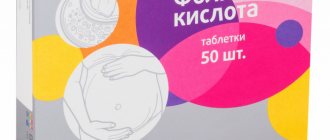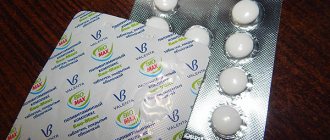Compound
The drug contains active ingredients: ascorbic acid - 175 mg, thiamine nitrate - 50 mg, riboflavin - 25 mg, calcium pantothenate - 25 mg, pyridoxine hydrochloride - 10 mg, folic acid - 500 mcg, cyanocobalamin - 5 mcg, nicotinamide - 100 mg .
Additional components: potato starch, magnesium stearate, colloidal anhydrous silicon dioxide, talc and calcium hydrogen phosphate.
The body and cap of the capsule consist of: FD&CA Red 3 dye, D&C Yellow 10 dye, gelatin, titanium dioxide (E171).
Contraindications
Allergic reactions to the components of the drug. acute thromboembolism, erythrocytosis and erythremia. Folic acid should not be used for malignant diseases, except in cases of megaloblastic anemia that has developed as a complication of folic acid deficiency. ascorbic acid is contraindicated in case of hyperoxaluria. tendency to thrombosis, thrombophlebitis, severe kidney disease, gastric and duodenal ulcers, severe liver dysfunction, active hepatitis, neoplasms, hypertension (severe forms), gout, hyperuricemia, nephrolithiasis, disorders of iron and copper metabolism, hypercalcemia.
Pharmacodynamics and pharmacokinetics
The effect of the drug is determined by the properties of the vitamins included in its composition.
After taking the capsules, one of the active components ( thiamine) is phosphorylated, resulting in the formation of cocarboxylase . This substance is a coenzyme , which is a participant in many enzymatic reactions. Thiamine is required for carbohydrate, protein and fat metabolism, and conduction of nerve impulses at synapses. Insufficiency of this substance leads to excessive concentrations of lactic and pyruvic acids , which can cause the development of polyneuritis , Wernicke encephalopathy, Korsakoff's syndrome, dysfunction of the heart , gastrointestinal tract and more.
Pyridoxine actively supports the functions of the nervous system. As a result of phosphorylation, a coenzyme is formed from vitamin B6 , which is necessary for the complete metabolism of amino acids and other enzymes found in nerve tissues. In addition, pyridoxine is involved in the biosynthesis of neurotransmitters : histamine, norepinephrine, adrenaline, serotonin, gamma-aminobutyric acid. Vitamin B6 deficiency can be caused by insufficient nutrition, dysfunction of the gastrointestinal tract, and the use of a number of medications that are classified as its antagonists. This can lead to the development of glossitis, stomatitis, convulsions, peripheral neuritis, anemia and other disorders.
Cyanocobalamin promotes normal hematopoiesis, the maturation of red blood cells and the flow of biochemical reactions that ensure the full functioning of the body: the production of nucleic acids , protein, the transport of methyl groups, the metabolic processes of amino acids, carbohydrates and lipids. It has been established that this substance has a positive effect on the functioning of the nervous system, development and cell replication. A lack of vitamin B12 is manifested by disturbances in the functioning of the hematopoietic and nervous systems, causing serious complications.
Riboflavin is an essential catalyst in the processes of visual perception and cellular respiration. After ingestion, the interaction of riboflavin and ATP is noted, resulting in the formation of flavin adenine nucleotide and flavin mononucleotide . These substances belong to coenzymes that transfer hydrogen and regulate redox processes. of riboflavin a in the processes of protein, carbohydrate and fat metabolism, maintaining full visual function and hemoglobin has also been noted . A lack of vitamin B2 can cause hyporiboflavinosis, and subsequently ariboflavinosis . With hyporiboflavinosis, appetite decreases, weight decreases, weakness, headaches , burning of the skin, pain in the eyes, impaired twilight vision, and pain in the corners or lower lip develop. Further development of the disease is accompanied by cracks or crusts on the lips in the form of angular stomatitis, dryness and redness of the tongue, seborrheic dermatitis in the area of the nasolabial folds, the appearance of photophobia, conjunctivitis, and blepharitis. It is also possible to increase the secretory function of the stomach, increase bile secretion, and facilitate the absorption of carbohydrates in the small intestine.
Nicotinamide is necessary for tissue respiration, metabolism of fats, carbohydrates and amino acids.
Calcium pantothenate is one of the components of coenzyme A , which is involved in the acetylation and oxidation of fats and carbohydrates, the production of bile acids and hormones.
Folic acid is important for the complete synthesis of red blood cells, carbohydrate metabolism, cell division and development. With a lack of folic acid, inhibition of the transition from the megaloblastic phase of hematopoiesis to the normoblastic phase is noted, which causes megaloblastic anemia.
Ascorbic acid is a regulator of redox processes involved in the synthesis of collagen, catecholamines, steroid hormones and folic acid metabolism. This substance is necessary for the formation of bones and teeth, the absorption of useful components by the body, for example: iron, beta-carotene, calcium and vitamin E. The importance of vitamin C in the process of regulating blood clotting, stimulating hematopoiesis, and vascular permeability has been noted. In addition, ascorbic acid is a strong antioxidant that weakens the effect of free radicals that lead to damage to healthy cells. The body's resistance to external adverse factors and the body's resistance to viral and bacterial infections also increases. of histamine decreases , thereby mitigating cold symptoms - rhinitis , lacrimation, redness of the conjunctiva. Vitamin C helps improve mental and physical performance, and activates basic metabolism.
All components included in Neurobeks Neo are water-soluble vitamins, so their accumulation in the body is excluded.
Absorption of thiamine and pyridoxine occurs in the upper part of the intestine, after which their uniform distribution in the body is noted. In this case, the degree of absorption is directly dependent on the dosage. The absorption process of cyanocobalamin is determined by the presence of intrinsic factor in the upper intestine and stomach. The substance is delivered to the tissue by the transport protein transcobalamin II.
As a result of rapid and easy absorption, riboflavin is distributed quite unevenly within the body - most of it is noted in the myocardium, kidneys and liver.
Absorption of folic acid occurs in the form of simple hydrolysates. A small part of the enzymes that perform hydrolysis are located in the duodenum and small intestine. The substance penetrates almost all tissues of the body. At the same time, a third of the substance in the form of methylfolate is found in the liver.
Rapid absorption of nicotinamide occurs from the gastrointestinal tract, and then the substance is evenly distributed in tissues and organs.
Ascorbic acid by rapid absorption in the intestine. Then the circulation of vitamin C is noted in the composition of the blood plasma, and the concentration in the glandular tissue. In this case, the main concentration of the substance is found in tissues, platelets and lymphocytes .
Calcium pantothenate is also easily and quickly absorbed from the gastrointestinal tract, after which it is concentrated in the heart, kidneys and liver.
Metabolism of thiamine, pyridoxine and cyanocobalamin occurs in the liver. The metabolic process and biotransformation of folic acid have not been fully studied. Metabolism of nicotinamide occurs through methylation, resulting in the formation of inactive metabolites . The metabolism of ascorbic acid produces oxalic acid and other water-soluble metabolites.
The elimination of this drug occurs through almost all organs of the excretory system. Pyridoxine and thiamine are excreted through the kidneys, and when taking high doses, through the intestines. Excretion of cyanocobalamin occurs mainly with bile, riboflavin, nicotinamide, ascorbic acid and calcium pantothenate - with urine unchanged or in the form of metabolites.
Side effects
From the digestive system: rarely - anorexia, nausea, bloating/flatulence; frequency unknown - vomiting, stomach cramps, diarrhea.
From the immune system: rarely - allergic reactions, including erythema, rash, itching, urticaria, shortness of breath and anaphylactic reactions (including shock), anaphylaxis, fever.
From the side of blood vessels: frequency unknown - hot flashes.
From the skin and subcutaneous tissue: rarely - urticaria, exanthema, eczematous rash. Allergic reactions include skin manifestations and angioedema. Frequency unknown - redness.
From the nervous system: frequency unknown - headache.
From the kidneys and urinary system: frequency unknown - slight increase in urination.
It is known that the following adverse reactions have been reported when using individual components of the drug.
From the respiratory system: bronchospasm.
From the cardiovascular system: hypertension, myocardial dystrophy.
From the blood: hemolysis of erythrocytes in patients with glucose-6-phosphate dehydrogenase deficiency, blood clotting disorders.
From the nervous system: dizziness, sleep disturbance, increased excitability, fatigue.
From the digestive system: dyspepsia, heartburn, belching, stomach pain, increased secretion of gastric juice, damage to the insular apparatus of the pancreas and impaired glycogen synthesis up to the onset of diabetes mellitus, damage to the glomerular apparatus of the kidneys, formation of stones in the kidneys and urinary tract, renal failure , change in urine color.
Other: hypercalciuria, crystalluria, glucosuria, feeling of heat, impaired zinc and copper metabolism, irritability, hyperhidrosis.
During long-term use of high doses of individual components of the drug, the following adverse reactions may occur: hyperuricemia, impaired glucose tolerance, hyperglycemia, paresthesia, convulsions, arrhythmia, arterial hypotension, erythrocytopenia, neutrophilic leukocytosis, gastrointestinal disorders, hair loss, seborrhea, hyperpigmentation, renal failure, jaundice, fatty liver, myalgia, myopathy, temporary increase in the levels of AST, ALP, LDH, increase in the level of uric acid in the blood, electrolyte imbalance.
Indications for use
Neurobex Neo is prescribed in combination therapy for various conditions and diseases:
- asthenic syndrome, chronic fatigue syndrome, stress, vegetative-vascular dystonia, encephalopathy, osteochondrosis, neuritis, polyneuritis, peripheral paralysis, radiculitis, lumbago, sciatica, neuralgia, spastic conditions of central origin, myasthenia gravis, traumatic lesions of the central nervous system;
- hepatitis, liver cirrhosis, chronic pancreatitis, gastrointestinal dysfunction;
- chronic circulatory failure, myocarditis, myocardial dystrophy , recovery period after cardiovascular diseases;
- diabetes mellitus and its complications, thyroid diseases;
- neurodermatitis, eczema, acne, dermatitis of various origins, herpes zoster;
- circulatory disorders in the retina, myopia, astigmatism, amblyopia, glaucoma, diabetic retinopathy, macular degeneration, optic neuritis, cataracts;
- menstrual disorders, mastopathy, conservative treatment of uterine fibroids, salpingoophoritis, endometritis ;
- reduced immunity , acute infectious diseases;
- Acoustic neuritis, sensorineural hearing loss, labyrinthopathy;
- during antibiotic therapy that suppresses gram-negative intestinal flora;
- chronic diseases, in old age, when using alcohol or tobacco.
Note!
Description of the drug Neurobex Neo caps. No. 60 on this page is a simplified author’s version of the apteka911 website, created on the basis of the instructions for use.
Before purchasing or using the drug, you should consult your doctor and read the manufacturer's original instructions (attached to each package of the drug). Information about the drug is provided for informational purposes only and should not be used as a guide to self-medication. Only a doctor can decide to prescribe the drug, as well as determine the dose and methods of its use.
Interaction
The simultaneous use of Neurobex Neo with levodopa may lead to a decrease in its antiparkinsonian effectiveness.
With long-term treatment with anticonvulsants - phenobarbital, phenytoin and carbamazepine in combination with Neurobex Neo, thiamine deficiency .
The combination of this drug with colchicine or biguanides leads to a decrease in the absorption of cyanocobalamin.
special instructions
It should be used with caution and in lower doses for angina pectoris due to its vitamin b12 content.
Due to the folic acid content, it should be used with caution in patients with suspected folate-dependent tumors.
Increased intake of ascorbic acid over a long period can lead to increased renal clearance and, if the drug is discontinued too quickly, to its deficiency.
When used in high doses or with long-term use of the drug, it is necessary to monitor renal function and blood pressure levels, as well as pancreatic function. The drug should be used with caution in patients with a history of kidney disease.
The drug should not be prescribed in high doses to patients with increased blood clotting.
Because ascorbic acid increases iron absorption, its use in high doses may be harmful to patients with hemochromatosis, thalassemia, polycythemia, leukemia and sideroblastic anemia. Patients with high iron content in the body should use the drug in minimal doses.
Simultaneous use of the drug with an alkaline drink reduces the absorption of ascorbic acid, so you should not drink it with alkaline mineral water. Do not take the drug with hot drinks (especially coffee) or alcohol. Also, the absorption of ascorbic acid may be impaired by intestinal dyskinesia, enteritis and achylia.
Use with caution to treat patients with glucose-6-phosphate dehydrogenase deficiency.
Ascorbic acid can affect the results of laboratory tests, for example, when determining blood glucose, bilirubin, transaminase activity, and LDH.
Since ascorbic acid has a slight stimulating effect, it is not recommended to use the drug at the end of the day.
The drug should be taken with caution in patients with diabetes mellitus, degenerative heart diseases, cardiac decompensation, ischemic heart disease, diseases of the hematopoietic organs, gastrointestinal diseases, cholelithiasis, chronic pancreatitis, liver damage, patients with acute nephritis, glaucoma , hemorrhage, moderate arterial hypotension.
Urine may turn yellow, which is completely harmless and is explained by the presence of riboflavin in the drug.
The drug is not recommended to be prescribed simultaneously with other multivitamins, since an overdose of the latter in the body is possible.
Use during pregnancy or breastfeeding. Clinical studies on the use of Neurobex Neo during pregnancy have not been conducted, so the drug must be used with caution, especially in the first trimester, and only as prescribed by a doctor if the expected benefit of the drug outweighs the potential risk to the fetus/child.
Vitamin B6 passes into breast milk and crosses the placental barrier. High concentrations of vitamin B6 may also suppress milk production. Studies on the degree of secretion of vitamins into breast milk have not been conducted. The decision to stop breastfeeding or use the drug must be made taking into account the importance of taking the drug for the mother. If it is necessary to use the drug, you should stop breastfeeding for this period.
The ability to influence reaction speed when driving vehicles or working with other mechanisms. Not found.
Reviews for Neurobex Neo
As you know, vitamins and vitamin complexes are an important component in maintaining a healthy body. Therefore, such drugs are especially popular in society. At the same time, reviews of Neurobeks Neo show that this is a fairly effective vitamin remedy. These capsules help improve the general condition of the body and quickly recover from illnesses.
However, experts warn patients that they should not prescribe such drugs on their own. Firstly, there are a certain number of contraindications to taking any vitamins, and secondly, before trying to compensate for the deficiency of any component, it is important to accurately establish the need for this. For this reason, you can choose a vitamin supplement wisely only together with your doctor, based on laboratory data.
Overdose
In some individuals with glucose-6-phosphate dihydrogenase deficiency, ascorbic acid may lead to the development of acidosis or hemolytic anemia. With a significant overdose of ascorbic acid, renal failure may develop.
Ascorbic acid is a water-soluble vitamin, and excess amounts are excreted in the urine. However, with long-term use of vitamin C in high doses, inhibition of the function of the insular apparatus of the pancreas is possible, which requires monitoring the condition of the latter. Overdose may lead to changes in the renal excretion of ascorbic and uric acids due to acetylation of urine with the risk of precipitation of oxalate stones.
In case of an overdose of the drug, dyspeptic symptoms, allergic reactions, changes in the skin and hair, liver dysfunction, headache, drowsiness, lethargy, facial flushing, and irritability are possible. In such cases, the drug should be discontinued.
It is necessary to perform gastric lavage and, if necessary, other supportive therapy measures.
Excess vitamin B is easily eliminated from the body, so no serious problems are expected after the administration of vitamin B in this dosage form.



